Emissions and CO2 Concentration—An Evidence Based Approach
Abstract
1. Introduction—A New Way of Looking at the Problem
Overview of Methods
2. The Absorption Model
2.1. Mass Conservation
- C the CO concentration of the atmosphere at the end of year i,
- the global emissions of human origin during year i,
- the global land use net emissions during year i,
- the global natural net emissions during year i,
- other special causes of emissions, such as El Nino, volcanos, etc.,
- the global net absorption of CO during year i into the oceans and biosphere ():
- The phase before 1900, where explicit emissions are smaller than implicit ones, due to land use change; however, there is a small, but increasing, CO concentration growth.
- The phase between 1900 and 1950 with growing emissions, but approximately constant CO concentration growth and slightly increasing land use change.
- The phase from 1950 to 2010 with growing emissions and growing concentration growth.
- Recent publications indicate that emissions have remained approximately constant since 2010 [12] and are expected to remain approximately constant for the forseeable future [13] (their Figure 2, stated policies scenario). The challenge is to estimate reasonable projections of CO concentration based on these emission assumptions.
2.2. Exploratory Analysis
2.3. Hypothesis 1: The Absorption A Is Proportional to Previous CO Concentration
- Net primary production of plants,
- Phytoplankton production, a smaller effect of dead biomass sinking to large depths of the ocean,
- Gas exchange with the deep ocean.
2.3.1. Temperature Dependence of the Absorption Parameter
2.3.2. CO Concentration as a Hypothetical Proxy for Temperature
2.3.3. Corollary: Carbon Sinks Are Not Expected to Be Saturated in the Near Future
- (1)
- We can test the past 70 years for linearity. If there was any sign of saturation, this would have shown up as a deviation from the linearity assumption. We will see that, in the residual deviations from the model, if the actual absorption parameter decreased with time, the real CO concentration at the end would be larger than estimated by the model.
- (2)
- The global carbon budget [10] clearly shows an increasing trend in both the ocean sink, as well as the (biosphere) land sink.
- (3)
- A recent article revised the estimates of the ocean-atmosphere CO flux [15], making it consistent with the increasing ocean sink found in the global carbon budget.
- (4)
- We can make a rough estimation of the expected ocean uptake. The ocean has a total carbon inventory of 38,000 GtC ≈ 140,000 Gt CO. If we assume the realistic scenario of constant future emissions at today’s level (37 Gt CO per year) and we assume that they are all absorbed by the ocean, by 2100 that would be approx. 3000 Gt CO, just about 2% of the current ocean inventory.
2.4. Hypothesis 2: Natural Emissions and Absorptions Are Balanced
- A systematic “trend” in the natural emissions. This would either increase or decrease the estimated absorption factor and the equilibrium concentration given a constant model of natural emissions,
- Short-term zero centered variations within a year. These variations do not show up in our model, due to the one year sampling interval,
- Long-term variations of more than a year are not averaged out. They are visible in the residual error of the predicted CO content.
2.5. The Modelling Equations
2.5.1. Prediction and Model Validation
- Assumed constant absorption parameter;
- Assumed temperature-dependent absorption parameter;
- Assumed absorption parameter dependent on temperature modelled by CO concentration.
2.5.2. Estimation with Limited Data Range and Model Validation
- As stated above, there is no large variability of both CO emissions and CO concentration before the year 1900. Moreover, the measurements at that time were not really reliable. Therefore, the signal-to-noise ratio is so large that, for the determination of concentration changes as a function of CO emissions, it is better to dispense with these data.
- We want to evaluate the predictive quality of the data model. Therefore, we limit the training data to 1999 and compare the predicted CO concentration of the years 2000 to 2020 with the actual measurements.
- We further argue that the data of the first part of the 20th century are also not really reliable, indicated, e.g., by the nearly constant yearly change of CO concentration, despite growing emissions, as well as the extreme uncertainty of land use change data. We also know that CO concentration measurement methods have greatly improved in the 1950s [22]. We will, therefore, make an evaluation with training data from 1950 to 1999 and build the model based on these data.
2.5.3. Estimation Based on Data from 1950 to 2000
2.5.4. Validation Based on Data from 1950 to 2000
3. Prediction and Future Scenario
3.1. Prediction of 2021–2100 CO2 Concentration on the Basis of the 2021–2050 IEA Stated Policies Emission Scenario
4. Conclusions
- The undeniable mass conservation of CO,
- The assumption of approximate linearity of the relevant absorption processes w.r.t. CO concentration. This assumption has been relaxed to allow for temperature-dependent absorption,
- The assumption that CO concentration can be used as an upper limit proxy for temperature, i.e., a part of the temperature changes that can be explained by CO concentration,
- The assumption of constant natural emissions is within the time period of measurement. We observed, however, apparent changes of natural emissions in the first half of the 20th century, resulting in a large prediction uncertainty. Further investigations are required for a better understanding, because these changes cannot be distinguished from land use changes, which also have a large uncertainty.
Author Contributions
Funding
Institutional Review Board Statement
Informed Consent Statement
Data Availability Statement
Acknowledgments
Conflicts of Interest
Appendix A. Relation to the Bern Model
Appendix A.1. Data Transformation of the Linear CO2 Concentration Model
- The linearity assumption of the absorptions;
- The assumption of constant natural emissions.
Appendix A.1.1. Relation to the Impulse Response Model, the Carbon Cycle Component of the Bern Model
Appendix B. Discussion of the Paper from Weber, Lüdecke and Weiss
Appendix C. Discussion of Harde’s Paper and Its Critics
- The mass conservation of CO can hardly be disputed, see Equation (1).
- The linear dependence of absorption from concentration (Equation (3)) has been extensively discussed above, and the deviations from this assumption in the measured data are so statistically insignificant, that it is not justified to dismiss a model assuming constant a.
- The assumption of a state of equilibrium between natural emissions and absorptions (his Equation (7)) during recent pre-industrial centuries is in my understanding scientific consensus (paleo-climate and its CO variability is not the issue here), and most mainstream publications explicitly or implicitly assume a constant pre-industrial CO concentration of approx. 280 ppm.
- Given the measured anthropogenic emissions, as well as the measured CO concentrations, the equation is well-posed and, therefore, can be solved without further equations.
- The remaining small residual errors have been recognized and discussed as being caused by e.g., the El Nino southern oscillation and volcanic eruptions [8], the systematic deviations in the first part of the 20th century remain to be fully evaluated.
References
- Siegenthaler, U.; Oeschger, H. Predicting Future Atmospheric Carbon Dioxide Levels: The predictions provide a basis for evaluating the possible impact of the continuing use of fossil fuel. Science 1978, 199, 388–395. [Google Scholar] [CrossRef] [PubMed]
- Maier-Reimer, E.; Hasselmann, K. Transport and storage of CO2 in the ocean—An inorganic ocean-circulation carbon cycle model. Clim. Dyn. 1987, 2, 63–90. [Google Scholar] [CrossRef]
- Joos, F.; Roth, R.; Fuglestvedt, J.S.; Peters, G.P.; Enting, I.G.; Von Bloh, W.; Brovkin, V.; Burke, E.J.; Eby, M.; Edwards, N.R.; et al. Carbon dioxide and climate impulse response functions for the computation of greenhouse gas metrics: A multi-model analysis. Atmos. Chem. Phys. 2013, 13, 2793–2825. [Google Scholar] [CrossRef]
- Strassmann, K.M.; Joos, F. The Bern Simple Climate Model (BernSCM) v1. 0: An extensible and fully documented open-source re-implementation of the Bern reduced-form model for global carbon cycle–climate simulations. Geosci. Model Dev. 2018, 11, 1887–1908. [Google Scholar] [CrossRef]
- Raupach, M.R.; Canadell, J.G.; Le Quere, C. Anthropogenic and biophysical contributions to increasing atmospheric CO2 growth rate and airborne fraction. Biogeosciences 2008, 5, 1601–1613. [Google Scholar] [CrossRef]
- Bennedsen, M.; Hillebrand, E.; Koopman, S.J. Trend analysis of the airborne fraction and sink rate of anthropogenically released CO2. Biogeosciences 2019, 16, 3651–3663. [Google Scholar] [CrossRef]
- Halparin, A. Simple Equation of Multi-Decadal Atmospheric Carbon Concentration Change. 2015. Available online: https://defyccc.com/docs/se/MDACC-Halperin.pdf (accessed on 12 March 2023).
- Spencer, R. A Simple Model of the Atmospheric CO2 Budget. 2019. Available online: https://www.drroyspencer.com/2019/04/a-simple-model-of-the-atmospheric-co2-budget/ (accessed on 12 March 2023).
- Weber, W.; Lüdecke, H.J.; Weiss, C. A simple model of the anthropogenically forced CO2 cycle. Earth Syst. Dyn. Discuss. 2015, 6, 2043–2062. [Google Scholar]
- Friedlingstein, P.; Jones, M.W.; O’Sullivan, M.; Andrew, R.M.; Bakker, D.C.; Hauck, J.; Le Quéré, C.; Peters, G.P.; Peters, W.; Pongratz, J.; et al. Global carbon budget 2021. Earth Syst. Sci. Data 2022, 14, 1917–2005. [Google Scholar] [CrossRef]
- Cawley, G.C. On the Atmospheric Residence Time of Anthropogenically Sourced Carbon Dioxide. Energy Fuels 2011, 25, 5503–5513. [Google Scholar] [CrossRef]
- Hausfather, Z. Global CO2 Emissions Have Been Flat for a Decade, New Data Reveals. Carbon Brief. 2021. Available online: https://www.carbonbrief.org/global-co2-emissions-have-been-flat-for-a-decade-new-data-reveals (accessed on 12 March 2023).
- IEA. World Energy Outlook, Scenario Trajectories and Temperature Outcome 2021. Available online: https://www.iea.org/reports/world-energy-outlook-2021/scenario-trajectories-and-temperature-outcomes (accessed on 12 March 2023).
- Duffy, K.A.; Schwalm, C.R.; Arcus, V.L.; Koch, G.W.; Liang, L.L.; Schipper, L.A. How close are we to the temperature tipping point of the terrestrial biosphere? Sci. Adv. 2021, 7, eaay1052. [Google Scholar] [CrossRef] [PubMed]
- Watson, A.J.; Schuster, U.; Shutler, J.D.; Holding, T.; Ashton, I.G.; Landschützer, P.; Woolf, D.K.; Goddijn-Murphy, L. Revised estimates of ocean-atmosphere CO2 flux are consistent with ocean carbon inventory. Nat. Commun. 2020, 11, 4422. [Google Scholar] [CrossRef] [PubMed]
- Oeschger, H.; Siegenthaler, U.; Schotterer, U.; Gugelmann, A. A box diffusion model to study the carbon dioxide exchange in nature. Tellus 1975, 27, 168–192. [Google Scholar] [CrossRef]
- Fischer, H.; Wahlen, M.; Smith, J.; Mastroianni, D.; Deck, B. Ice Core Records of Atmospheric CO2 Around the Last Three Glacial Terminations. Science 1999, 283, 1712–1714. [Google Scholar] [CrossRef] [PubMed]
- HadSST2. HadSST2—Met Office Sea Surface Temperature Anomalies Monthly Data, 1850–2013. 2013. Available online: https://www.metoffice.gov.uk/hadobs/hadsst2/diagnostics/global/nh+sh/monthly (accessed on 12 March 2023).
- Bloch-Johnson, J.; Rugenstein, M.; Stolpe, M.B.; Rohrschneider, T.; Zheng, Y.; Gregory, J.M. Climate Sensitivity Increases Under Higher CO2 Levels Due to Feedback Temperature Dependence. Geophys. Res. Lett. 2021, 48, e2020GL089074. [Google Scholar] [CrossRef]
- Herman, J.; DeLand, M.; Huang, L.K.; Labow, G.; Larko, D.; Lloyd, S.; Mao, J.; Qin, W.; Weaver, C. A net decrease in the Earth’s cloud, aerosol, and surface 340 nm reflectivity during the past 33 yr (1979–2011). Atmos. Chem. Phys. 2013, 13, 8505–8524. [Google Scholar] [CrossRef]
- Canadell, J.G.; Pataki, D.E.; Gifford, R.; Houghton, R.A.; Luo, Y.; Raupach, M.R.; Smith, P.; Steffen, W. Saturation of the Terrestrial Carbon Sink. In Terrestrial Ecosystems in a Changing World; Canadell, J.G., Pataki, D.E., Pitelka, L.F., Eds.; Springer: Berlin/Heidelberg, Germany, 2007; pp. 59–78. [Google Scholar] [CrossRef]
- JPL. A Brief History of Carbon Dioxide Measurements. 2008. Available online: https://airs.jpl.nasa.gov/news/111/a-brief-history-of-carbon-dioxide-measurements/ (accessed on 12 March 2023).
- ENSO. Multivariate ENSO Index (MEI). 2018. Available online: https://psl.noaa.gov/enso/mei.old/mei.html (accessed on 12 March 2023).
- Harde, H. Scrutinizing the carbon cycle and CO2 residence time in the atmosphere. Glob. Planet. Change 2017, 152, 19–26. [Google Scholar] [CrossRef]
- Köhler, P.; Hauck, J.; Völker, C.; Wolf-Gladrow, D.; Butzin, M.; Halpern, J.; Rice, K.; Zeebe, R. Comment on “Scrutinizing the carbon cycle and CO2 residence time in the atmosphere”. Glob. Planet. Change 2018, 164, 67–71. [Google Scholar] [CrossRef]
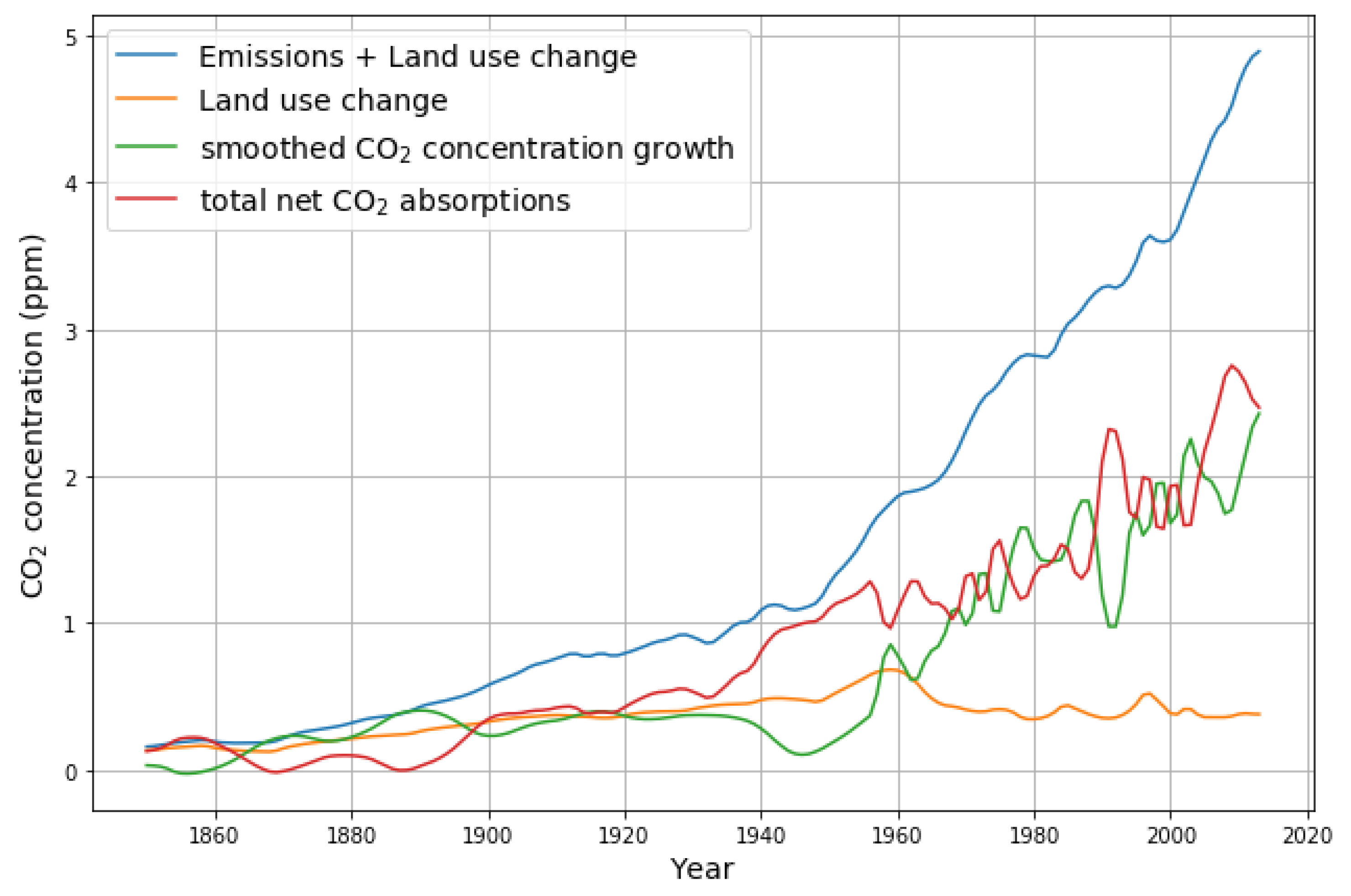
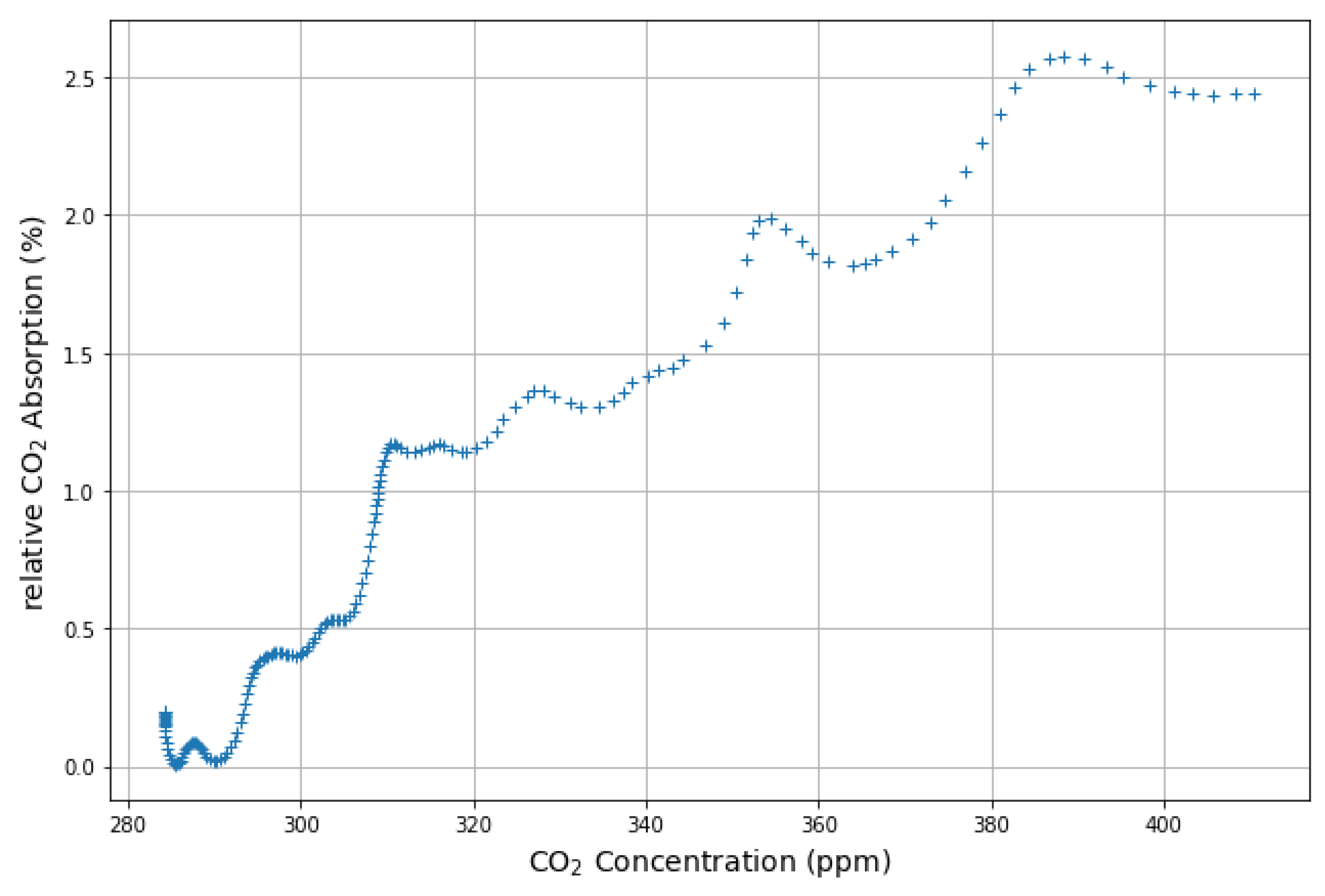
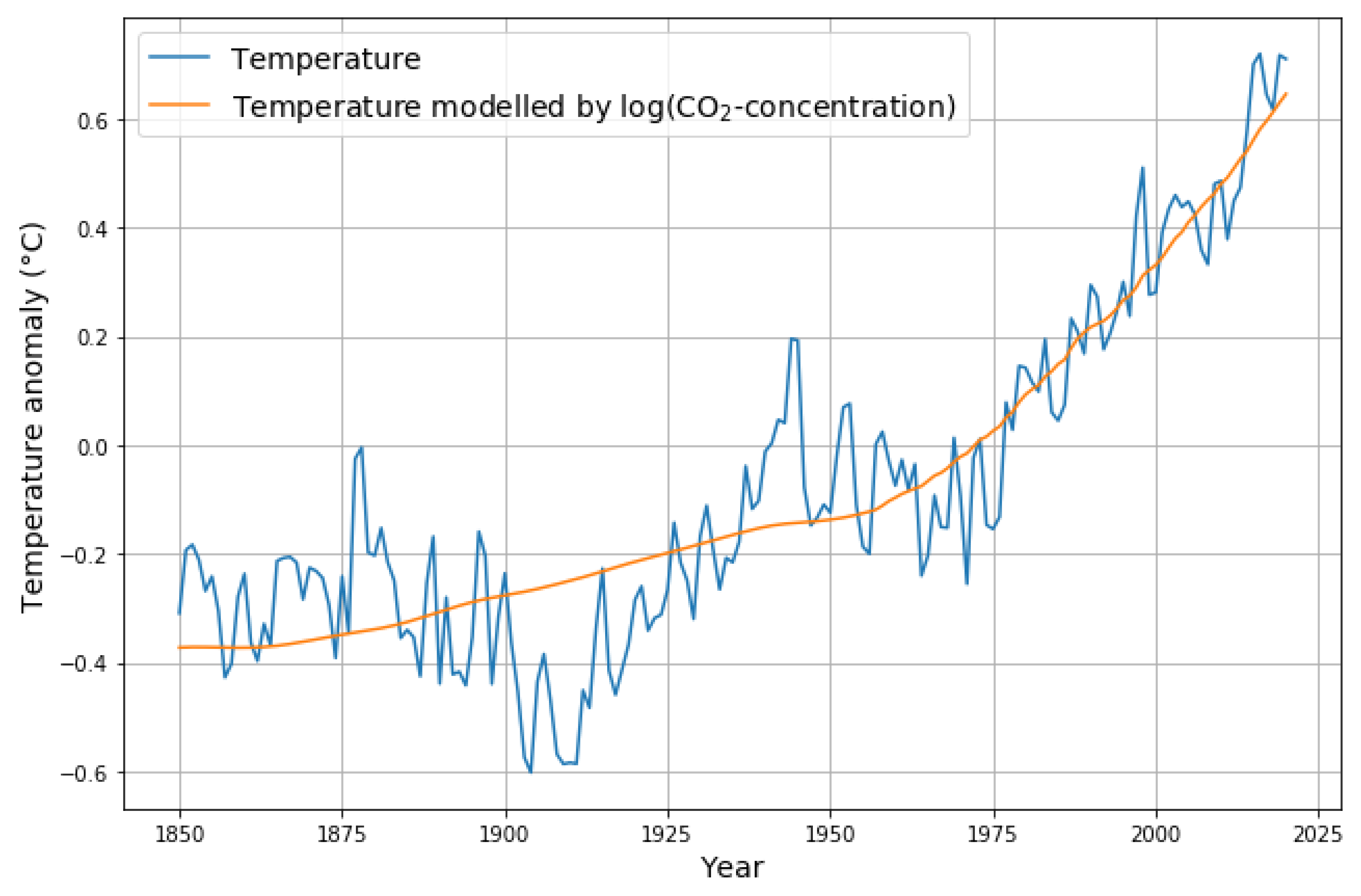
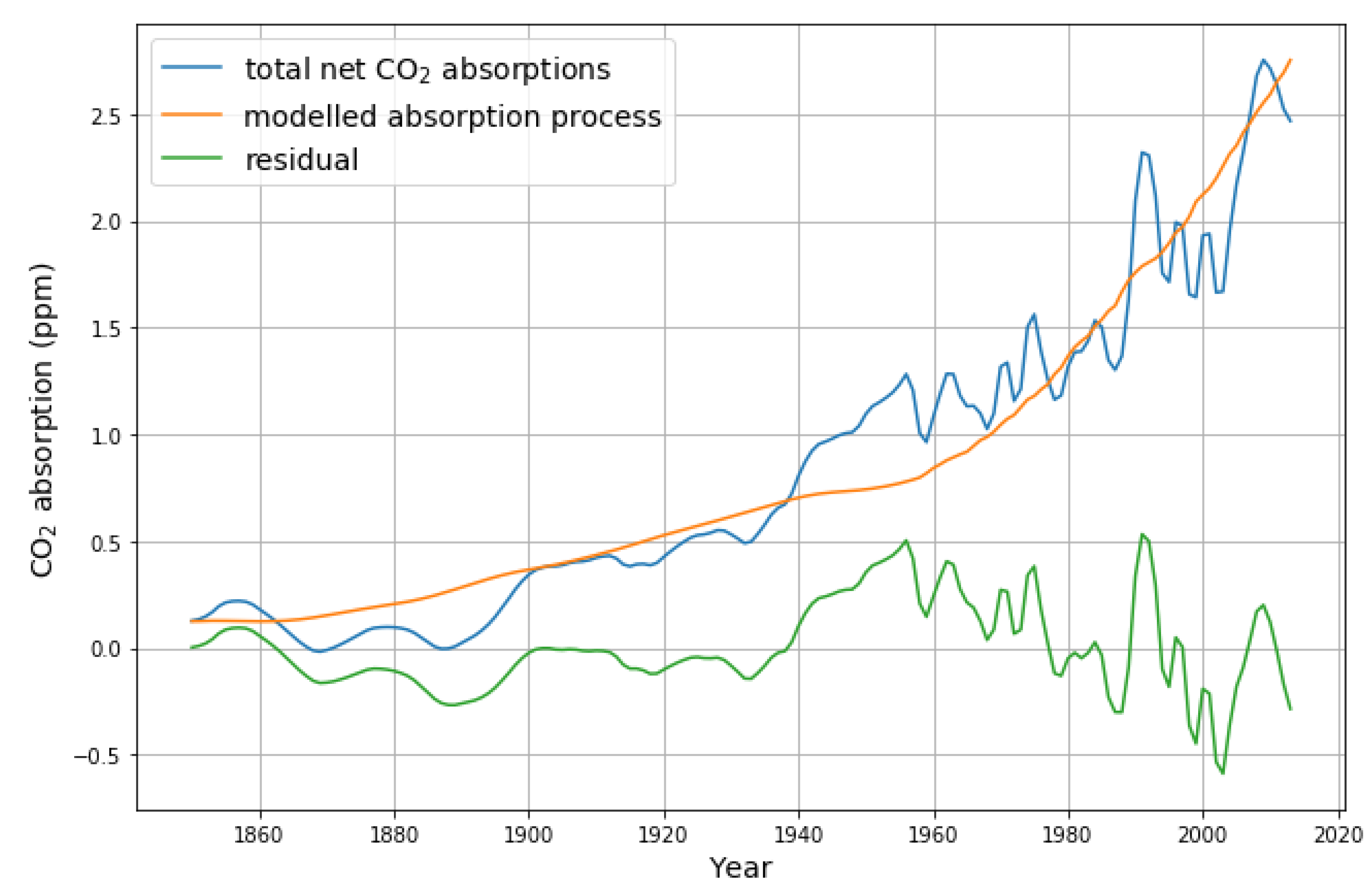
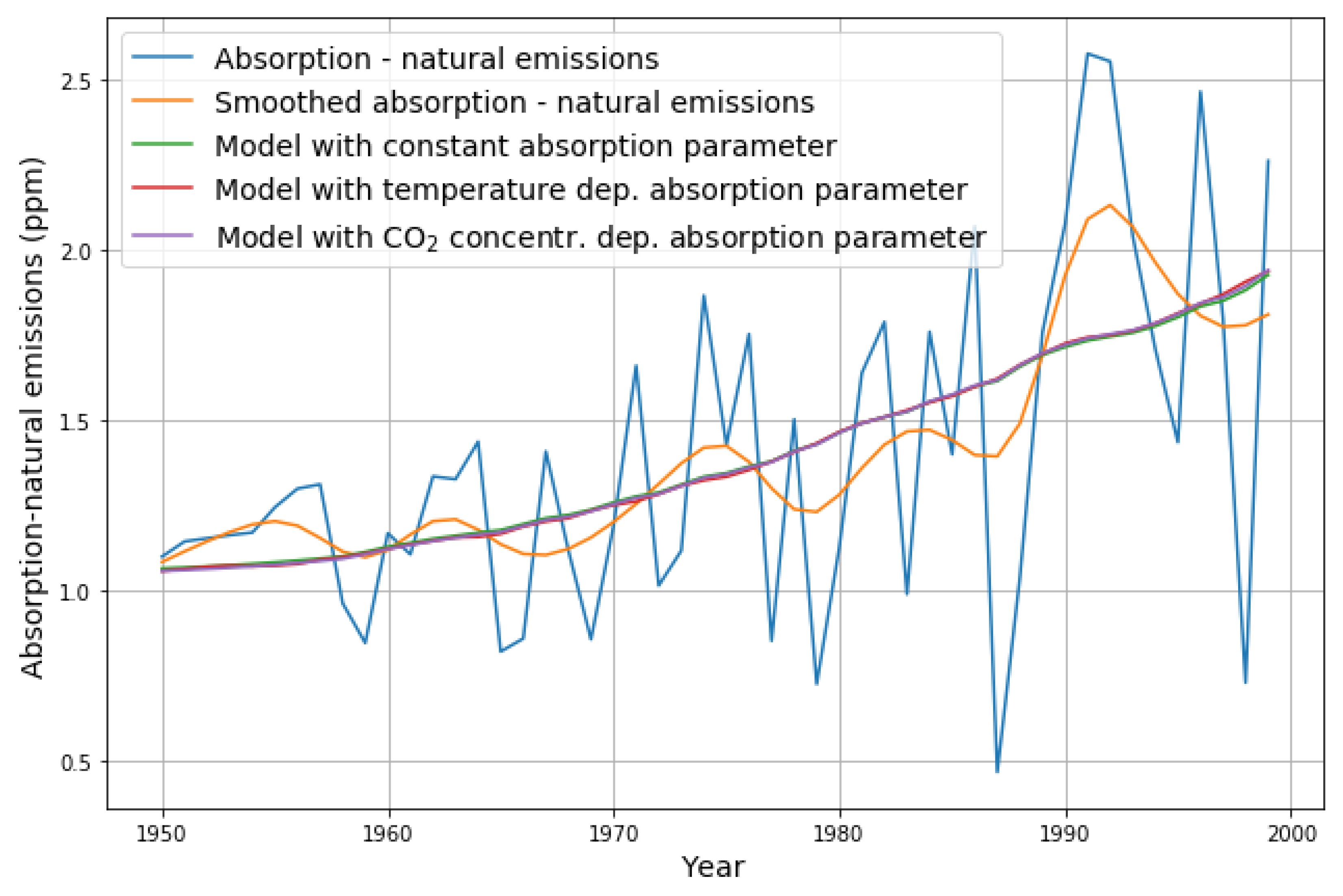
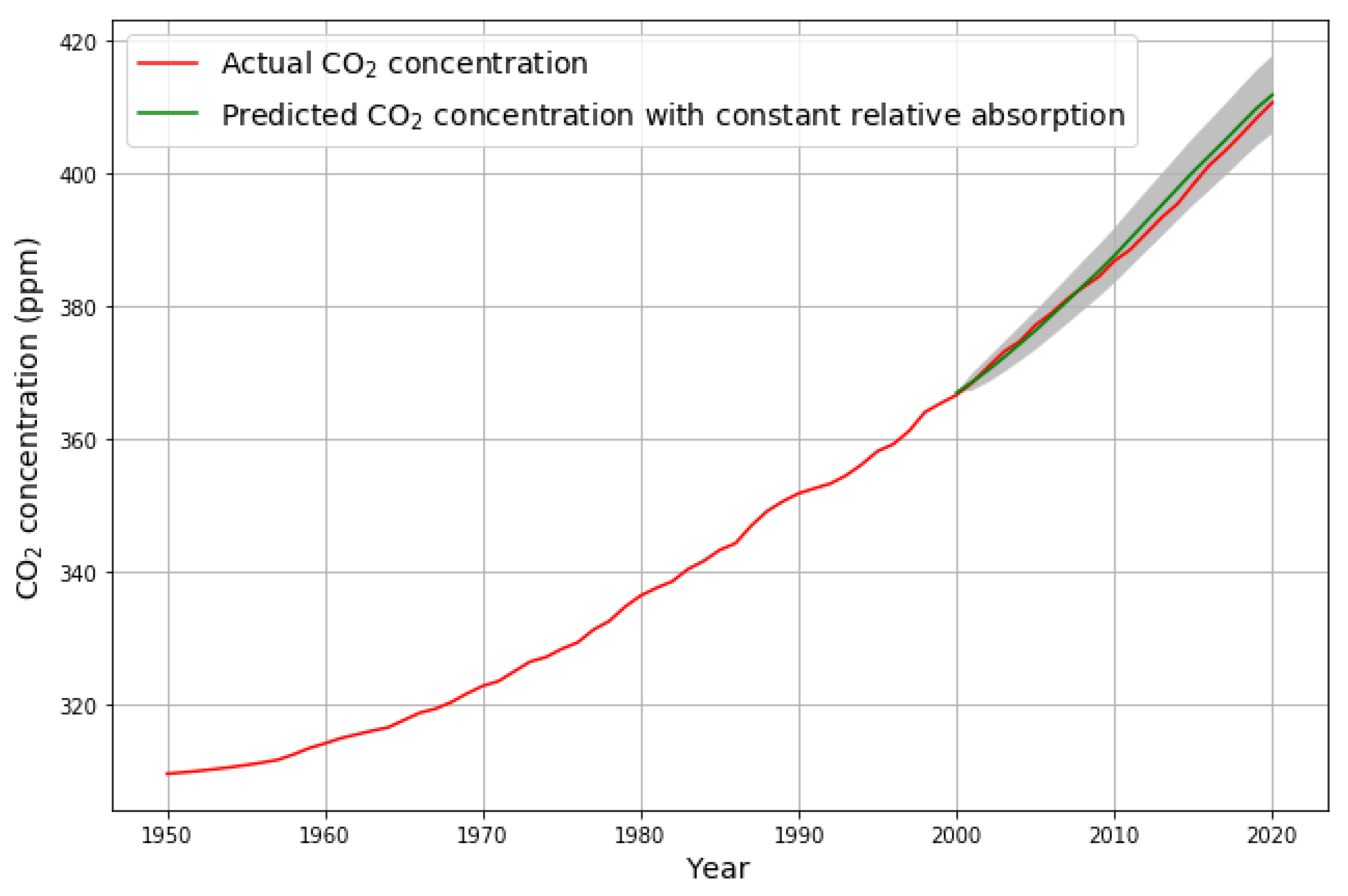
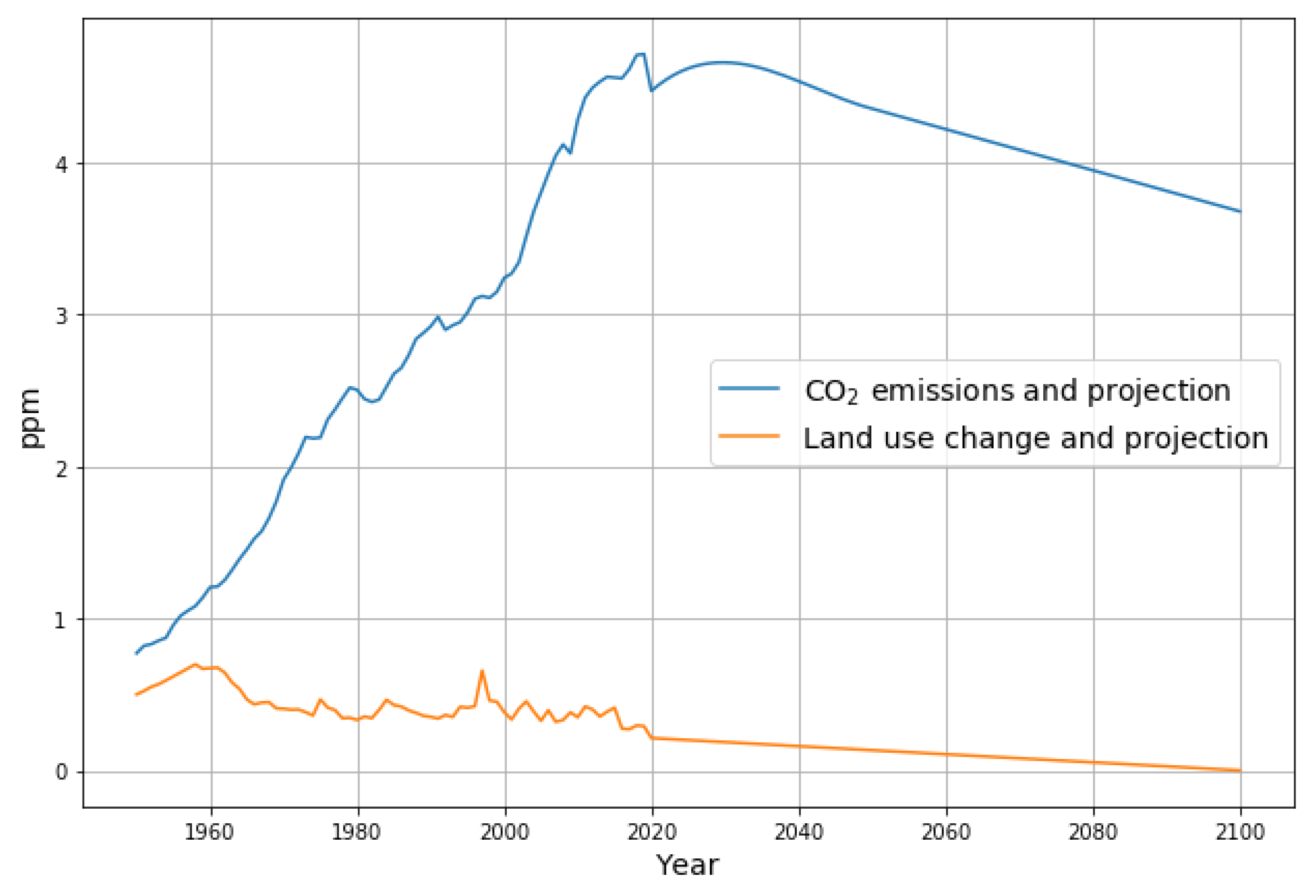
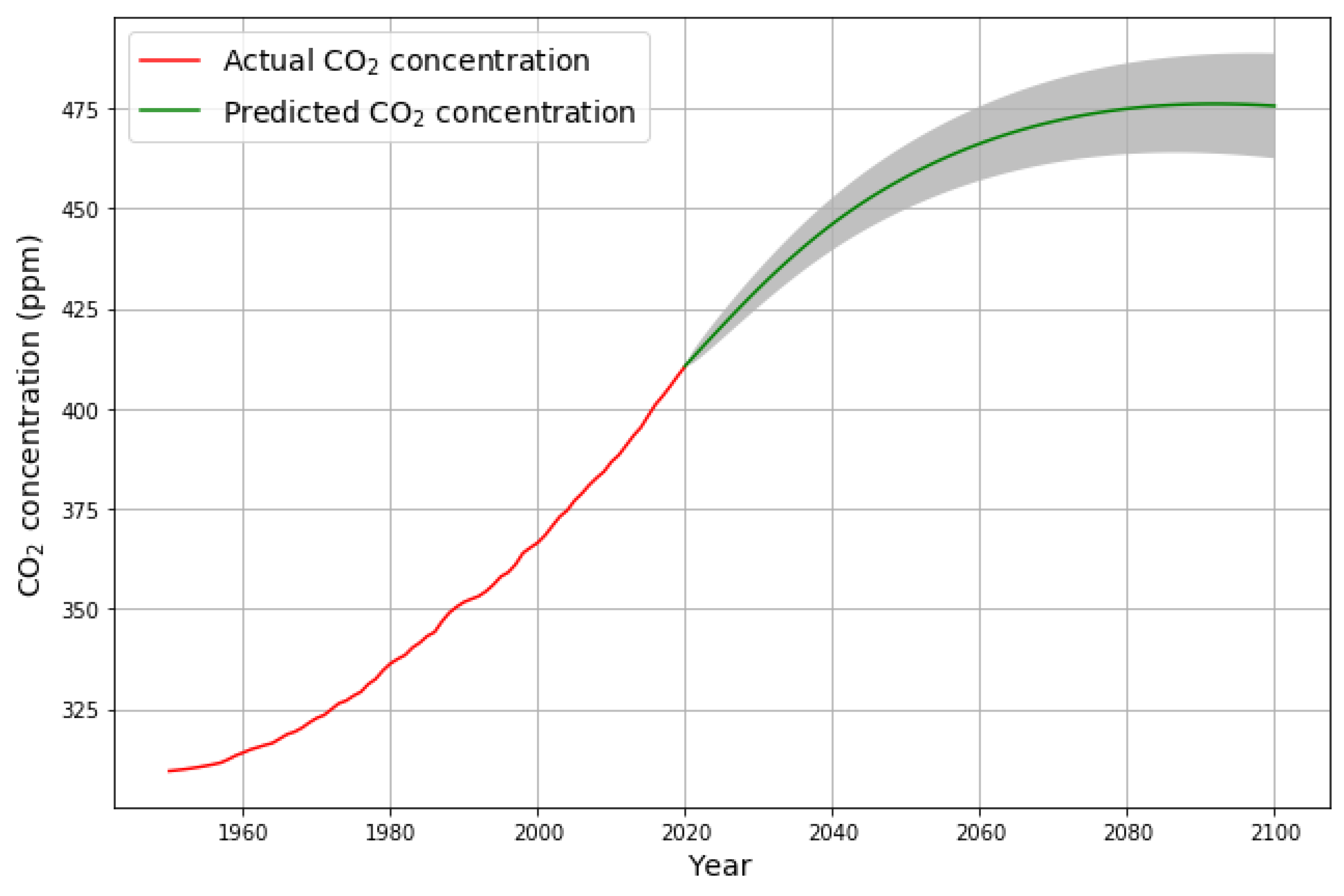
| Coef. | Std.Err. | t | [0.025 | 0.975] | ||
|---|---|---|---|---|---|---|
| −6.8952 | 0.2640 | −26.1142 | 0.00 | −7.4166 | −6.3738 | |
| a | 0.0247 | 0.0008 | 29.3485 | 0.00 | 0.0230 | 0.0264 |
| Coef. | Std.Err. | t | [0.025 | 0.975] | ||
|---|---|---|---|---|---|---|
| a | 0.0263 | 0.0007 | 39.6674 | 0.00 | 0.0250 | 0.0276 |
| a | −0.0082 | 0.0025 | −3.2074 | 0.00 | −0.0132 | −0.0031 |
| Coef. | Std.Err. | t | [0.025 | 0.975] | ||
|---|---|---|---|---|---|---|
| −3.8188 | 0.2640 | −14.4670 | 0.00 | −4.3496 | −3.2881 | |
| a | 0.0158 | 0.0008 | 19.7789 | 0.00 | 0.0142 | 0.0174 |
| Coef. | Std.Err. | t | [0.025 | 0.975] | ||
|---|---|---|---|---|---|---|
| a | 0.0157 | 0.0002 | 92.4536 | 0.00 | 0.0154 | 0.0161 |
| a | 0.0005 | 0.0008 | 0.6142 | 0.54 | −0.0011 | 0.0021 |
| Coef. | Std.Err. | t | [0.025 | 0.975] | ||
|---|---|---|---|---|---|---|
| a | 0.0157 | 0.0002 | 90.0473 | 0.00 | 0.0154 | 0.0161 |
| a | 0.0005 | 0.0010 | 0.4667 | 0.64 | −0.0016 | 0.0025 |
| Coef. | Std.Err. | t | [0.025 | 0.975] | ||
|---|---|---|---|---|---|---|
| −4.0355 | 0.1684 | −23.9655 | 0.00 | −4.3714 | −3.6996 | |
| a | 0.0165 | 0.0005 | 34.0113 | 0.00 | 0.0155 | 0.0174 |
Disclaimer/Publisher’s Note: The statements, opinions and data contained in all publications are solely those of the individual author(s) and contributor(s) and not of MDPI and/or the editor(s). MDPI and/or the editor(s) disclaim responsibility for any injury to people or property resulting from any ideas, methods, instructions or products referred to in the content. |
© 2023 by the authors. Licensee MDPI, Basel, Switzerland. This article is an open access article distributed under the terms and conditions of the Creative Commons Attribution (CC BY) license (https://creativecommons.org/licenses/by/4.0/).
Share and Cite
Dengler, J.; Reid, J. Emissions and CO2 Concentration—An Evidence Based Approach. Atmosphere 2023, 14, 566. https://doi.org/10.3390/atmos14030566
Dengler J, Reid J. Emissions and CO2 Concentration—An Evidence Based Approach. Atmosphere. 2023; 14(3):566. https://doi.org/10.3390/atmos14030566
Chicago/Turabian StyleDengler, Joachim, and John Reid. 2023. "Emissions and CO2 Concentration—An Evidence Based Approach" Atmosphere 14, no. 3: 566. https://doi.org/10.3390/atmos14030566
APA StyleDengler, J., & Reid, J. (2023). Emissions and CO2 Concentration—An Evidence Based Approach. Atmosphere, 14(3), 566. https://doi.org/10.3390/atmos14030566






